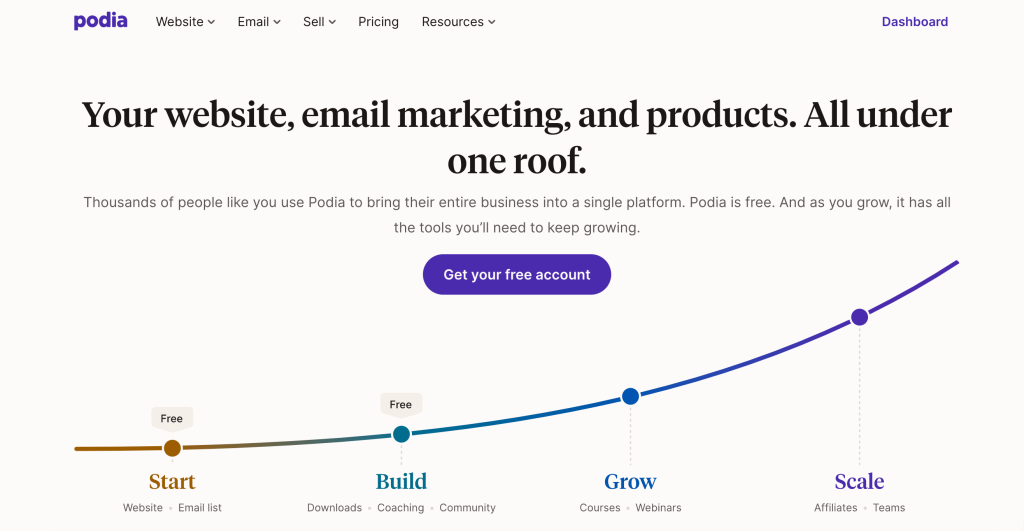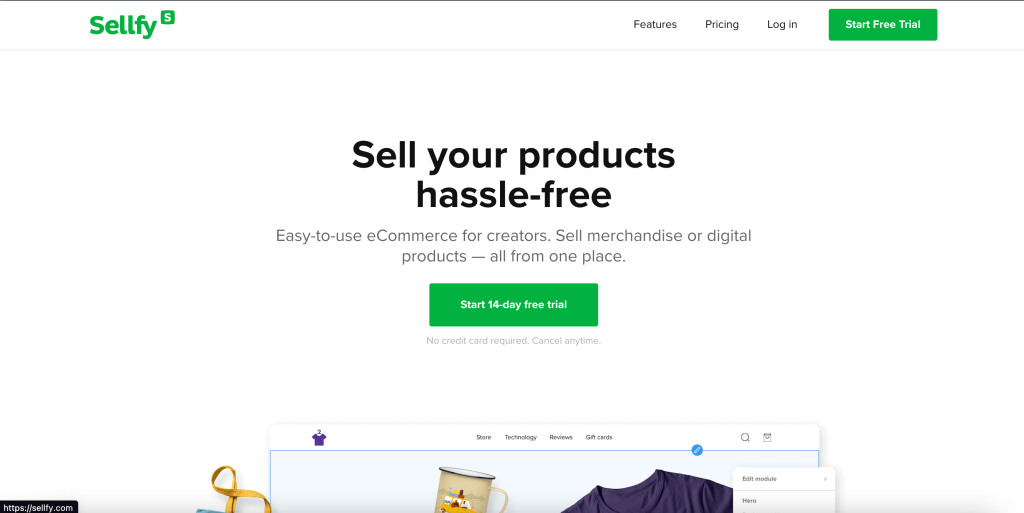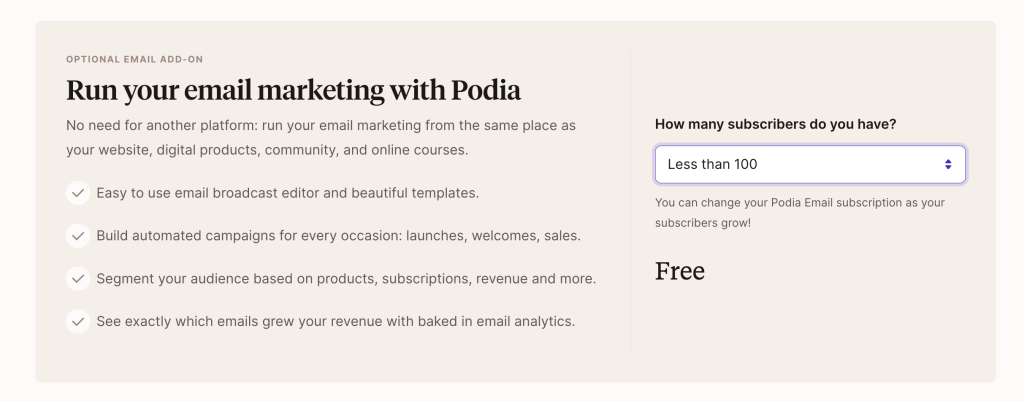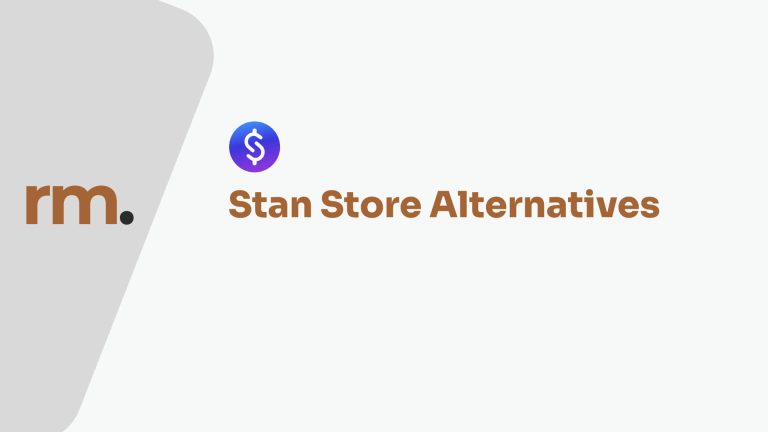As a digital content creator, there are many platforms you can use to monetize your content. We looked at the most popular platforms to sell your digital products, and the two mentioned were Podia and Sellfy. In this Podia vs Sellfy comparison, we provide a detailed look at its features, pricing and who it is most suitable for.
We are seeing a drastic growth in the demand for digital marketplaces. Both Podia and Sellfy have risen to the challenge, offering robust marketing tools and integrations that empower content creators to build their brands and connect with their audience on a deeper level.
We take a deeper look at the nuances between the two platforms that can make all the difference for creators like you keen on maximizing the online presence. In this comparison article, we’ll dive into the nitty-gritty of Podia and Sellfy, dissecting their features, pricing, and suitability for different types of sellers, to help you make an informed decision in your quest for the perfect platform to create your digital storefront.
Podia vs Sellfy: Who is most suited for?
While Podia shines as a multifaceted platform for digital content creators, offering tools for webinars and affiliate marketing, Sellfy steps up as an e-commerce powerhouse with features like print-on-demand and advanced analytics. Both platforms, however, share a common goal: to empower creators and entrepreneurs in building and scaling their online presence.
Podia: ideal for building a community around your offers

Podia is most suitable for a variety of content creators and entrepreneurs who are looking to monetize their knowledge and skills through digital products and services. This includes:
- Online Educators: Instructors and teachers who want to create, market, and sell online courses and educational content.
- Coaches and Consultants: Professionals who offer personal coaching or consulting services and may want to supplement their offerings with digital downloads, webinars, or memberships.
- Creators and Influencers: Individuals with a following who want to monetize their audience by selling digital goods, such as ebooks, guides, or exclusive video content.
- Artists and Musicians: Those who produce creative work and want to sell it directly to their fans, such as digital art, music files, or instructional videos.
- Membership Site Owners: Entrepreneurs looking to build a community around their brand or niche and offer exclusive content and interactions through memberships.
- Bloggers and Writers: Content creators in the writing space who want to sell their written work or offer courses on writing skills.
- Entrepreneurs with a Mix of Offerings: Business owners who want to sell a combination of digital products, memberships, and online courses from one platform.
The platform is designed to be user-friendly, requiring no technical skills to set up and manage, which makes it appealing to creators who prefer to focus on content creation rather than the technical aspects of running an online store. With features that support video hosting, email marketing, and community building, Podia is particularly well-suited for those who want an all-in-one solution to grow their online business.
Sellfy: ideal for creators focusing on selling product-based offers

Sellfy is most suited for independent creators, small businesses, and entrepreneurs who are looking for an easy-to-use e-commerce platform to sell both digital and physical products directly to their audience. This includes:
- Digital Product Creators: Individuals selling digital downloads such as ebooks, music, videos, photography, software, and digital art.
- Merchandise Sellers: Creators who want to sell branded merchandise through print-on-demand services, which Sellfy supports, allowing for the sale of custom-designed apparel, accessories, and more without holding inventory.
- Physical Product Vendors: Small businesses that have physical goods to sell and ship to customers, which Sellfy can facilitate alongside digital products.
- Filmmakers and Musicians: Artists who want to sell their work directly to their fans, including films, albums, and singles.
- Graphic Designers and Illustrators: Professionals who create digital assets like design templates, illustrations, and graphic packs.
- Online Educators and Course Creators: Although not as focused on courses as Podia, Sellfy still provides the means for these creators to sell educational content.
- Subscription-Based Product Sellers: Sellfy allows for the sale of subscription-based products, which can be appealing to creators who offer ongoing content or services.
Sellfy’s platform is designed to be straightforward and user-friendly, with an emphasis on a quick setup process, making it a good choice for creators who want to start selling without the need for extensive customization or technical knowledge. Additionally, with the capability to sell a wide range of product types and the inclusion of marketing tools to help promote products, Sellfy is a versatile choice for creators looking to build and grow their online business.
What does Podia and Sellfy offer?
We’ve established that both platforms are great for content creators looking to sell their offers online.
Similarities between Podia and Sellfy
Podia and Sellfy share several similarities as platforms designed to help creators sell products and content online:
- Digital Product Sales: Both Podia and Sellfy enable creators to sell digital products such as ebooks, courses, music, and more.
- Online Storefront: They provide users with the tools to set up an online storefront to showcase and sell their products directly to customers.
- Content Hosting: Each platform hosts the content, meaning that creators don’t need to worry about finding separate hosting for their digital products.
- Payment Processing: Podia and Sellfy handle payment processing, allowing customers to purchase products seamlessly.
- Marketing Tools: Both platforms offer various marketing tools to help creators promote their products, including email marketing and discount codes.
- No Product Limits: According to the Podia vs. Sellfy comparison, both platforms do not limit the number of products you can sell.
- Free Trials: Podia and Sellfy offer free trials, with Podia providing a 14-day free trial to test out their platform.
These similarities make both platforms suitable for creators looking to monetize their digital and creative work. However, the choice between them would depend on specific features, pricing, and the individual needs of the creator.
What are the main differences between Podia vs Sellfy?
You’re probably here to know how they mainly differ. Here’s what we’ve found:
- Product Types: While both platforms support digital products, Podia offers a broader range of product types including memberships, webinars, and online courses, whereas Sellfy is more focused on creators selling digital goods, physical products, and print-on-demand merchandise.
- Membership and Community Features: Podia provides features for memberships and community building, allowing creators to offer subscription-based content and engage with their audience through a built-in community platform. Sellfy does not have a native community feature.
- Email Marketing: Podia has more robust email marketing tools built-in, enabling creators to send newsletters, drip campaigns, and targeted emails. Sellfy offers email marketing features but they are as comprehensive.
- Video Hosting: Podia includes video hosting for online courses and digital products, while Sellfy does not offer its own video hosting, requiring users to integrate with YouTube or Vimeo for video content.
- Print-on-Demand: Sellfy supports print-on-demand services, allowing creators to sell custom-designed merchandise without holding inventory. Podia does not offer print-on-demand services.
- Physical Products: Sellfy allows the sale of physical goods in addition to digital products, whereas Podia focuses exclusively on digital products, memberships, and online courses.
- Pricing Structure: Podia’s pricing is based on a monthly subscription model with different tiers based on the features you need. Sellfy also offers a subscription model but includes a free plan with basic features, making it accessible for new sellers to start without upfront costs.
- Third-Party Integrations: Both platforms offer integrations with third-party tools, but the range and types of integrations may vary, with Podia often being noted for its integrations that support its membership and online course features.
When choosing between Podia and Sellfy, creators should consider their specific needs, such as the type of products they plan to sell, whether they need membership or community features, and their preferences for marketing and email communication tools.
Podia vs Sellfy: Pricing Information
Choosing a platform ultimately comes down to which platform provides good value for money. This Podia vs Sellfy review will not be complete until we look at how much each platform costs.
Both platforms offer different tiers to cater to the varying needs of creators, from those just starting to those with established businesses looking for more advanced features. Though both platforms, Podia and Sellfy, offer a 14-day trial, one of the most distinctive things to note is that Podia offers a free plan while Sellfy doesn’t. This is to stay true to one of their principles which “For everyone, equally”.
Let’s look at the pricing of each platform in more detail.
Note: It’s important to review each platform’s current pricing page for the most up-to-date and detailed information on what each plan includes and any additional fees that may apply.
Podia pricing
Podia pricing offers a range of plans:
- Free Plan: This plan has no subscription fee but includes an 8% transaction fee. It’s quite limited, allowing for the creation of one digital download and coaching product, and access to a membership website builder, but it does not support publishing or selling online courses and webinars.
- Starter Plan: Very similar to the free plan, but at $9/month (or $4/month paid annually), you get to add a custom domain and have access to chat support. It offers a lower transaction fee (8% vs 10% in the Free plan).
- Mover Plan: At $39/month (or $33/month paid annually), this plan includes unlimited courses, coaching products, and digital downloads. It also offers a lower transaction fee on sales (5% vs 8% in the Starter plan) , but lacks some advanced features.
- Shaker Plan: Priced at $89/month (or $59/month paid annually), it builds upon the Mover plan by adding certificates, unlimited webinar products, and an affiliate program. The main advantage of this plan is that it removes the transaction fee. Additionally, you’ll be able to convert your customers into advocates with their affiliate program feature.
All plans mentioned above doesn’t include email marketing. They are payable separately and is based on the number of subscribers.

Sellfy pricing
Sellfy pricing includes 3 plans and the rates differ based the frequency of payments (monthly, annually or two years).
- Starter Plan: Starting at $19/month, $22/month OR $29/month. This is designed for new businesses. It includes store customization, a custom domain, no transaction fees, unlimited products, and a maximum of $10,000 in annual sales.
- Business Plan: This plan offers more features and is designed for growing businesses. At $49/month, $59/month or $79/month, this plan suits larger businesses and includes features such as custom domain, discount codes, product upselling, store customization, 10,000 email credits, and a maximum of $50,000 in annual sales.
- Premium Plan: This is Sellfy’s highest-tier plan, offering the most features and designed for large businesses. Priced at $99/month, $119/month OR $159/month, this is tailored for large businesses with extensive sales. It includes free migration, discount codes, unlimited products, store customization, custom domain, priority support, 50,000 email credits, and up to $200,000 in annual sales.
Sellfy boasts about not having transaction fees or any hidden costs in all their plans which is true and I think is great.
Which one should you go for?
Sellfy is great for those looking for a simple, focused solution that offers a platform to sell digital and physical products, print-on-demand services or a straightforward setup process that appeals to those looking to quickly launch an online store.
On the other hand, Podia emerges as the superior option for creators who recognize the growing importance of community-based selling and engagement. In an era where building relationships with customers is as crucial as the products being sold, Podia’s integrated community features, comprehensive email marketing tools, and ability to host memberships, webinars, and online courses give creators a competitive edge.
The platform’s emphasis on creating an all-encompassing ecosystem for sellers to not only market and sell products but also to foster a loyal community positions it as a more holistic solution.
With the rise of the creator economy and the increasing preference for platforms that offer more than just transactional capabilities, Podia’s all-in-one approach aligns seamlessly with the trend towards community-driven commerce.
By enabling sellers to create, market, sell, and engage in one place, Podia not only simplifies the logistics of running an online business but also amplifies the potential for meaningful interactions and sustained growth.
In light of these considerations, Podia stands out as the better choice for creators who are looking to build a thriving online community alongside their sales strategy.



